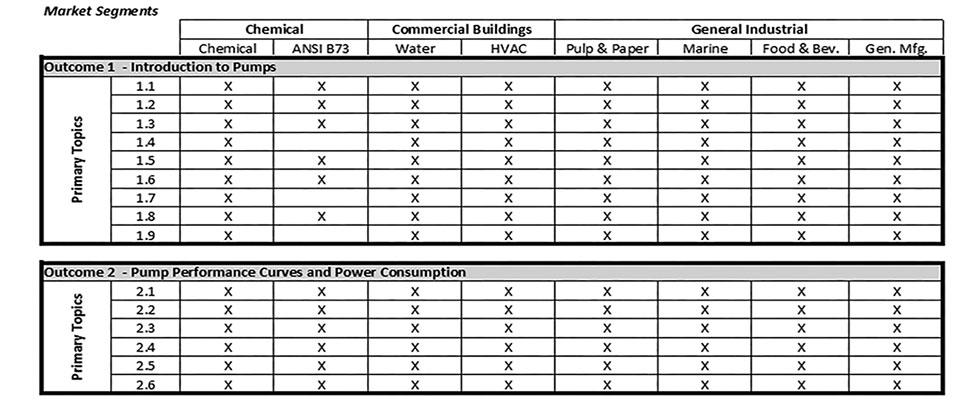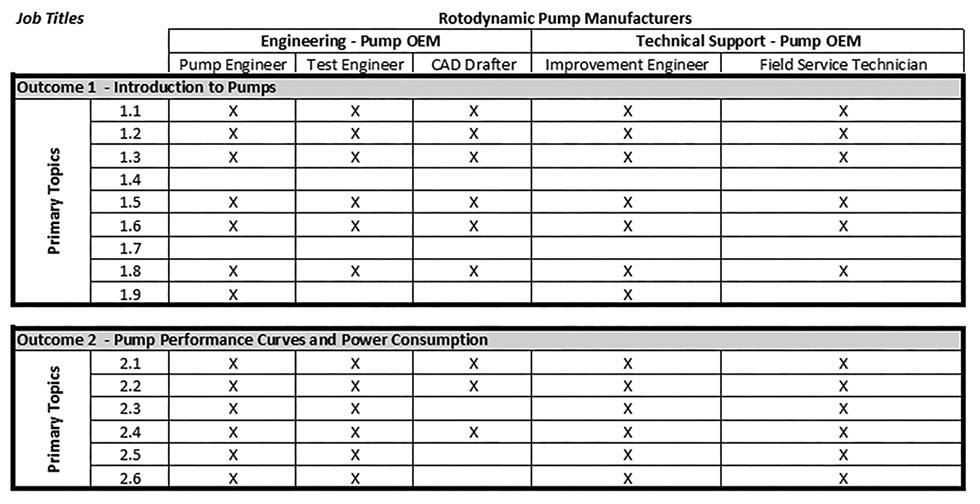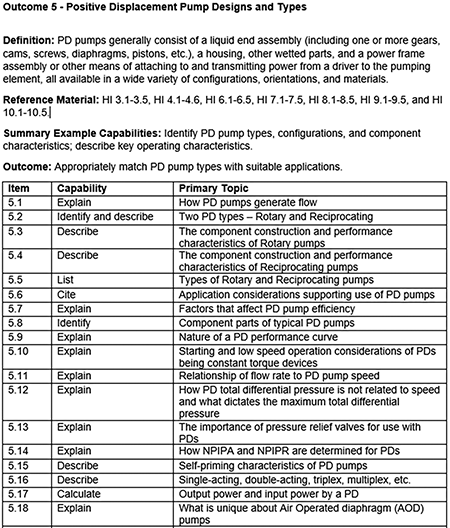
Investing in knowledge and education is critical to ensuring a resilient and sustainable future for the pumping and fluid handling industry, particularly in the face of workforce challenges. This article builds upon the discussion of workforce development introduced by Peter Gaydon, deputy executive director of the Hydraulic Institute (HI), in his piece titled “Pump System Fundamentals New Industry Professionals Should Know,” which was originally published in the September 2022 issue of Pumps & Systems magazine. By prioritizing education and training, the industry can cultivate a skilled and knowledgeable workforce capable of meeting the industry’s evolving needs and drive innovation required for sustainability.
The pumping and fluid handling industry is among the many industrial and manufacturing sectors facing significant workforce challenges. The industry’s objective is to attract young professionals to a mature and established trade that is required to support our way of life. This is crucial as the experienced workforce is approaching retirement age and taking with them valuable industry knowledge. Companies are therefore faced with the crucial task of educating and training new employees on their processes, products and services to maintain continuity and keep up with industry demands.
To address these challenges, the pump industry must communicate the importance of fluid handling to everyday life and emphasize how a career in this field provides a secure opportunity to impact society by providing essential equipment and services. HI has already taken steps in this direction with article series such as World Without Pumps, Pump PROfiles and Pump Pros Know. These series shed light on the overlooked importance of pumps and provide insights into what jobs in the pump industry entail and the necessary skills required. However, the most significant initiative has been the development of the HI 40.9-2022 Pump Industry Fundamentals Body of Knowledge (Image 1).

The Pump Industry Fundamentals Body of Knowledge (BoK) is a free comprehensive document that establishes fundamental knowledge requirements for professionals at all levels of the pump industry, from beginners to seasoned experts. It is a vital tool for attracting and training new workers, ensuring that they have the core knowledge to succeed in the pump industry. The BoK’s primary objective was to establish learning outcomes that are consistent across job functions and industries, serving as a roadmap to assist users in defining fundamental training or knowledge requirements for their specific market or job title. Although certain markets may have specific knowledge requirements, the BoK provides a strong foundation for success by outlining 16 learning outcomes accompanied by associated primary topics.
The market segments, as outlined in Appendix B of the BoK, include agriculture, chemical, commercial building, general industrial, municipal, oil and gas, power generation and residential. Appendix C of the BoK provides a comprehensive list of job titles with descriptions, encompassing manufacturing, engineering, sales, distributors, manufacturers’ representatives, as well as specifying engineers, consulting engineers and end users. Additionally, Appendix D of the BoK includes metrics that align market segments and job titles with specific primary topics (Images 2 and 3).


The 16 learning outcomes encompass broad areas of learning content relevant to the pump industry. These outcomes cover a wide range, starting from the introduction to pumps and extending all the way to markets and applications. The learning outcomes are as follows:
- Outcome 1 - Introduction to Pumps
- Outcome 2 - Pump Performance Curves and Power Consumption
- Outcome 3 - Pump Systems
- Outcome 4 - Rotodynamic Pump Designs and Types
- Outcome 5 - Positive Displacement Pump Designs and Types
- Outcome 6 - Pump Components and Accessories
- Outcome 7 - Drivers and Drives
- Outcome 8 - System Design Considerations
- Outcome 9 - Varying the Pump Operating Point
- Outcome 10 - Pump Selection, Specification and Application Engineering
- Outcome 11 - Testing
- Outcome 12 - Pump Installation, Commissioning and Startup
- Outcome 13 - Maintenance
- Outcome 14 - Troubleshooting
- Outcome 15 - Pump System Optimization and Analysis
- Outcome 16 - Markets and Applications
Each learning outcome is comprised of multiple primary topics, which represent discrete learning concepts. In total, there are over 300 primary topics covered within the BoK. Achieving mastery in a specific primary topic requires the acquisition of relevant capabilities. Capabilities are categorized into two types: knowledge and skill. The BoK primarily focuses on the knowledge acquisition and skill development requirements at the primary topic level. Additionally, each primary topic further includes multiple secondary topics, which provide more specific levels of knowledge and skills. It is worth noting that detailed and comprehensive training on these defined topics is outside the scope of the BoK.
The primary topics covered in the BoK span a wide range that can be used as a learning path for beginners and more seasoned professionals. Regardless of the complexity of the primary topic, the BoK aims to cover fundamental knowledge that is essential for the development and growth of professionals in the fluid handling industry. The organization of primary topics aligns them with specific skills or capabilities, such as defining, explaining, identifying, analyzing, calculating and more. This ensures comprehensive coverage of the necessary skills within the industry. Image 4 exemplifies 18 of the 29 primary topics integrated into learning outcome 5–Positive Displacement Pump Designs and Types.

While the BoK does not provide comprehensive training on the primary topics, companies, industry experts and training organizations have the capacity to develop applicable training. Here is an example of specific training that can be developed for primary topic 5.6 as shown in Image 4.
Primary Topic (Item) 5.6 – PD Pumps
For this primary topic, training could cover the following: PD pumps offer a range of application considerations that support their use in various scenarios. First, they are widely employed in applications involving high viscosity fluids. While rotodynamic pump types experience a drop in flow rate, head and efficiency as viscosity rises due to friction loss, PD pumps exhibit increased flow and volumetric efficiency with higher viscosity, making them capable of handling fluids across a broad viscosity range. Due to the increasing volumetric efficiency, PD pumps are effectively applied in applications where the viscosity varies without the need to dramatically oversize the motor while their flow rate and efficiency remain relatively stable even with changes in viscosity.
Certain PD pumps also demonstrate exceptional performance in handling multiphase fluids, as they can handle a high percentage of air or gas entrainment without losing their prime. This makes them ideal for applications with intermittent liquid flow or gas entrainment, such as draining foam tanks or pumping crude oil with varying phases.
PD pumps also stand out in applications where low shear is required, as they can displace fluids without excessive
shearing, making them perfect for food processing applications.
Additionally, PD pumps are applied with relative efficiency in low-flow and high-pressure applications, delivering nearly constant flow against variable pressures and while offering the ability to precisely meter flow.
Certification organizations and training bodies can take advantage of the BoK and effectively segment primary topics based on level or other methods to cater to the market’s needs. The Hydraulic Institute is currently undertaking this initiative and developing certifications that are based on the primary topics associated with the BoK. Although these have not been fully defined, the initial target is for the certifications to be divided into two levels, each with increasing levels of complexity. The first level is designed for new or entry-level individuals in technical and nontechnical roles. This certification will be applicable to all job functions within the pump industry. The next level is intended for more experienced technical and non-technical professionals with job functions in engineering, sales, assembly, installation, maintenance, troubleshooting or operations.
The first certification level will focus on foundational knowledge required for professionals in the pump industry, providing a testament to an individual’s essential competencies. These competencies include an in-depth understanding of pump curves, system curves and their interaction, basic principles of variable speed pumping and control, knowledge of various fluid properties, recognition of major pump components and comprehension of their functions, as well as the ability to perform basic calculations commonly used in the pump industry. This certification is applicable to many job functions and can benefit college students with an interest in the pump industry, entry-level engineers, sales and marketing employees and technicians.
The second level certification will be intended for more experienced technical and non-technical professionals. This certification will indicate that an individual has fundamental engineering knowledge that applies and is beneficial for all technical positions in the industry. The knowledge requirements are general engineering principles that benefit pump industry professionals in technical positions. The competencies will build on those from the first level and add additional competencies such as factory performance testing of pumps, understanding motor and variable frequency drive fundamentals, pump installation, maintenance and operation principles, familiarity with common pump and system operating issues, comprehension of pump life cycle costs and the ability to determine the necessary data for sizing a pump in a typical application.
Addressing workforce challenges in the pumping and fluid handling industry requires a concerted effort to attract and retain young professionals while preparing for the retirement of experienced workers. Investing in knowledge and education is crucial for a sustainable future, and initiatives like the BoK and certifications based on it play a pivotal role. By emphasizing the significance of fluid handling, promoting industry awareness and providing comprehensive resources, the industry can cultivate a skilled workforce capable of meeting evolving demands and driving innovation. This strategic approach ensures the industry’s continuity and growth, while also attracting new talent to contribute to its essential role in society.
To download a free copy of the HI 40.9-2022 Pump Industry Fundamentals Body of Knowledge, please visit the Hydraulic Institute at pumps.org/standards.

